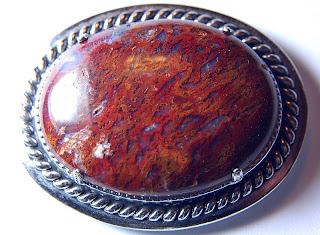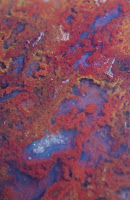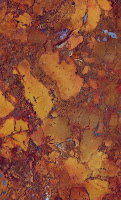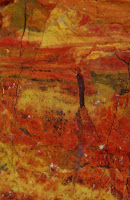As mentioned in my teaser post of March 9, my brother and I spent March 8 collecting rocks at Lavic Siding. Later in the day we visited a rock store in Barstow, where the owner told us that Lavic is nearly the only classic locality which still has abundant material, easily found. Our experience was little different from visits to Lavic that I've made going back forty years.
 This image taken from the "road" stop from which we began to collect, shows the Cady Mountains to the north. They are considered to be the source of the Jasper. A quarry in the Cady's was used for aggregate for the Route 66 topping, and I could see jasper in the asphalt. The Cady Mountains are reworked sediment, so when we say "source" we don't mean ultimate source; that is unknown, but occasional lava-jasper contact material indicates that the jasper is older than Pisgah crater and its lava fields, which are nearby.
This image taken from the "road" stop from which we began to collect, shows the Cady Mountains to the north. They are considered to be the source of the Jasper. A quarry in the Cady's was used for aggregate for the Route 66 topping, and I could see jasper in the asphalt. The Cady Mountains are reworked sediment, so when we say "source" we don't mean ultimate source; that is unknown, but occasional lava-jasper contact material indicates that the jasper is older than Pisgah crater and its lava fields, which are nearby.We collected to the right, on the low hills, and behind the camera viewpoint. The ground is open, and the bushes are not nearly as abundant as they appear in this low-angle photo.
 This is a typical view of the rocky ground that composes the alluvial hills. The visible jasper pieces here are all less than two inches (5 cm) in their largest dimension. Sometimes, you'll encounter a piece that doesn't "want" to be picked up. A little digging reveals a chunk of jasper that could be up to the size of a fist. Not many are larger than that.
This is a typical view of the rocky ground that composes the alluvial hills. The visible jasper pieces here are all less than two inches (5 cm) in their largest dimension. Sometimes, you'll encounter a piece that doesn't "want" to be picked up. A little digging reveals a chunk of jasper that could be up to the size of a fist. Not many are larger than that.The challenge is to gather solid pieces without porosity. Many pieces have abundant holes throughout. Such pieces don't polish well, unless you want to epoxy-fill a rough-ground piece and polish that. There is enough solid material to be had, that there is no need for such measures.
 This high-crowned cabochon I made in 1970 has some of the nicest moss-jasper pattern I've ever seen. It is often called jasp-agate, having the texture of moss agate, but being primarily jasper "shreds" in a clear-to-milky-bluish chalcedony matrix. Some of the chalcedony forms little fortification agates, and I like such pieces the best.
This high-crowned cabochon I made in 1970 has some of the nicest moss-jasper pattern I've ever seen. It is often called jasp-agate, having the texture of moss agate, but being primarily jasper "shreds" in a clear-to-milky-bluish chalcedony matrix. Some of the chalcedony forms little fortification agates, and I like such pieces the best.We probably didn't find material that is its equal on this trip, but what we found is pretty good. A closeup of the cabochon, and three typical textures from rocks collected on this trip are shown below. They show what I like about Lavic jasper. All but the first were photographed under water, which gives a better idea what they'll look like when polished. The three are broken surfaces, so there's no desert varnish or caliche to obstruct the view.
 This closeup, right near the center of the cabochon, shows the red-brown-yellow jasper shreds, the clear matrix, and the bluish spots, including one mini-agate. This is classic. Whatever the process that formed the jasper, it had to be complex.
This closeup, right near the center of the cabochon, shows the red-brown-yellow jasper shreds, the clear matrix, and the bluish spots, including one mini-agate. This is classic. Whatever the process that formed the jasper, it had to be complex.The whole area here is just 5x9 mm, and it ought not be hard to find on the image above of the cabochon, which measures 40x30 mm. That is the "large standard" cabochon, by the way. If you go to a rock show, most of the cabochons on display by dealers are this size or smaller. It's hard to wear a stone much bigger than this, unless it is in a Western-style belt buckle. I have a big belt buckle or two, but haven't had the temerity to make a big stone for a belt!
 The area of this view and those below is about 20x35 mm, so these three stones could probably produce 30x40 mm cabochon rough. Also, all three weigh a little less than a pound (about 0.4 kg, I suppose). This stone is just a little smaller than my fist.
The area of this view and those below is about 20x35 mm, so these three stones could probably produce 30x40 mm cabochon rough. Also, all three weigh a little less than a pound (about 0.4 kg, I suppose). This stone is just a little smaller than my fist.This stone has plenty of bluish-white inclusions, including a nice mini-agate. It is the reddest piece I found. The pattern is less distinct than in the moss jasper, but is nice enough to keep the stone from being as boring as red paint. That is the trouble with a lot of red jasper: it is just red.
 This piece is a breccia, a cemented-together, and now solid, agglomeration of broken chunks. The stone is smaller than the one just above, but only by a little.
This piece is a breccia, a cemented-together, and now solid, agglomeration of broken chunks. The stone is smaller than the one just above, but only by a little.The beige to yellow to brown colors seen here are more common than the red, but are less popular. However, a stone such as this has plenty of textural interest, and I find it of great beauty.
There is something about breccia that appeals on a deep level. Perhaps it is the beauty-out-of-trial aspect.
 This layered piece shows a very common texture. The stone is the same size as the one just above.
This layered piece shows a very common texture. The stone is the same size as the one just above.Layered jasper has more color variety; the colors in this one include green, yellow, and red. I haven't seen much green jasper from Lavic. The green color usually requires either chrome or iron in a semi-reduced state. The intense reds and yellows here indicate the main colorant is fully oxidized iron. In its presence, I don't know how the green color forms.
Lavic jasper and jasp-agate are mysteries, beautiful ones.



No comments:
Post a Comment